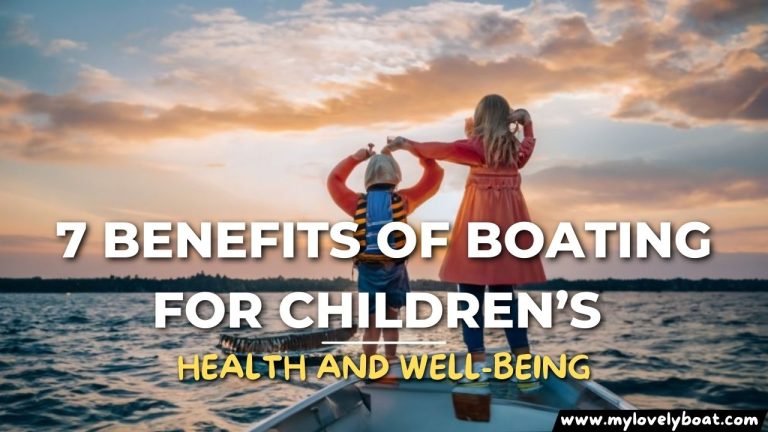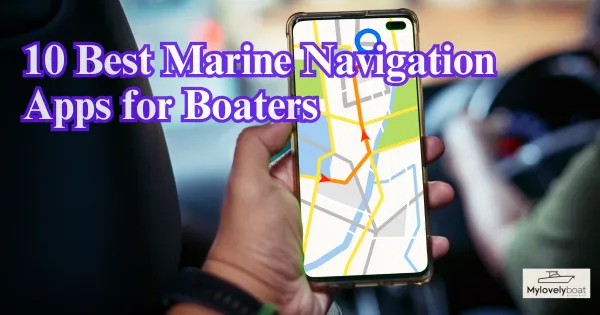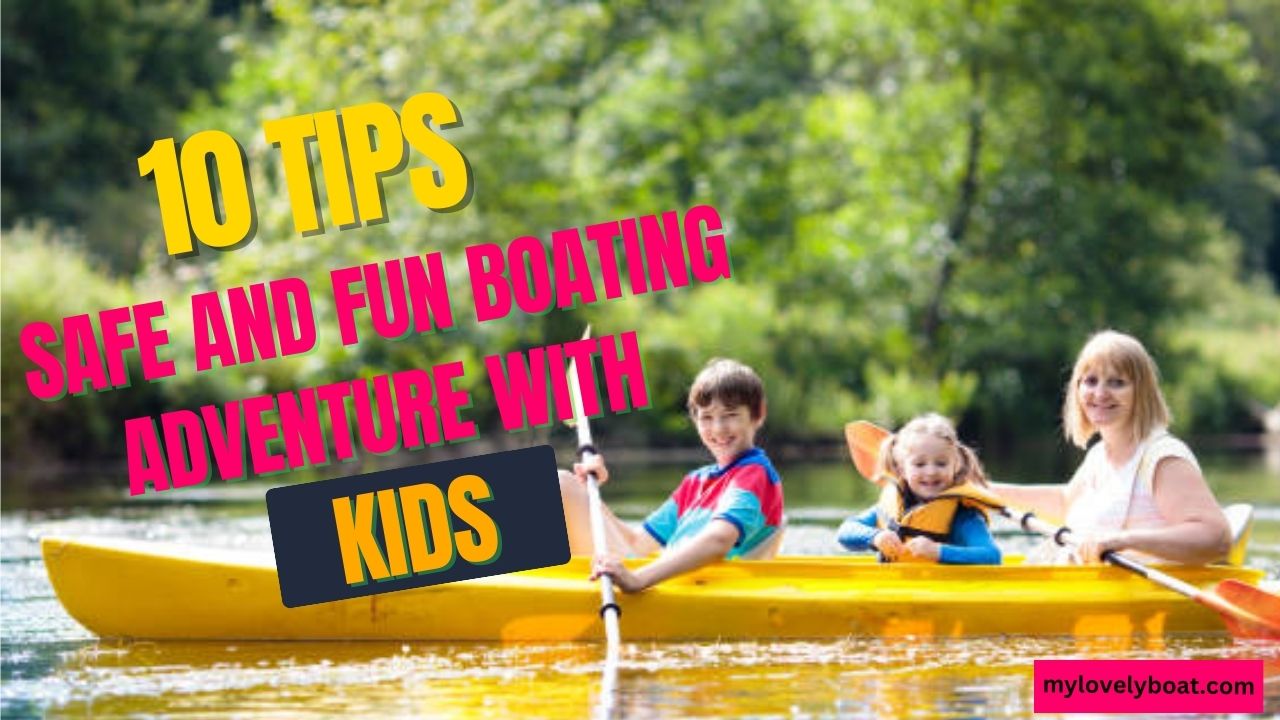
Why You Can Trust: We are dedicated to providing our readers with the most comprehensive, expert advice on a wide range of products. If you buy through our links, we may get a commission.
Think back to some of your best childhood memories – they are likely filled with adventures and family, right?
Imagine giving your kids the same glory but at sea, sharing the thrill of a boating adventure. Isn’t it exciting? Yes, indeed! But ensuring safety alongside fun is crucial.
So, let’s dive into the top 10 tips to make your boat days safe and enjoyable for your kids.
Here Are 10 Tips for A Safe and Fun Boating Adventure with Kids

1 – Life Jackets
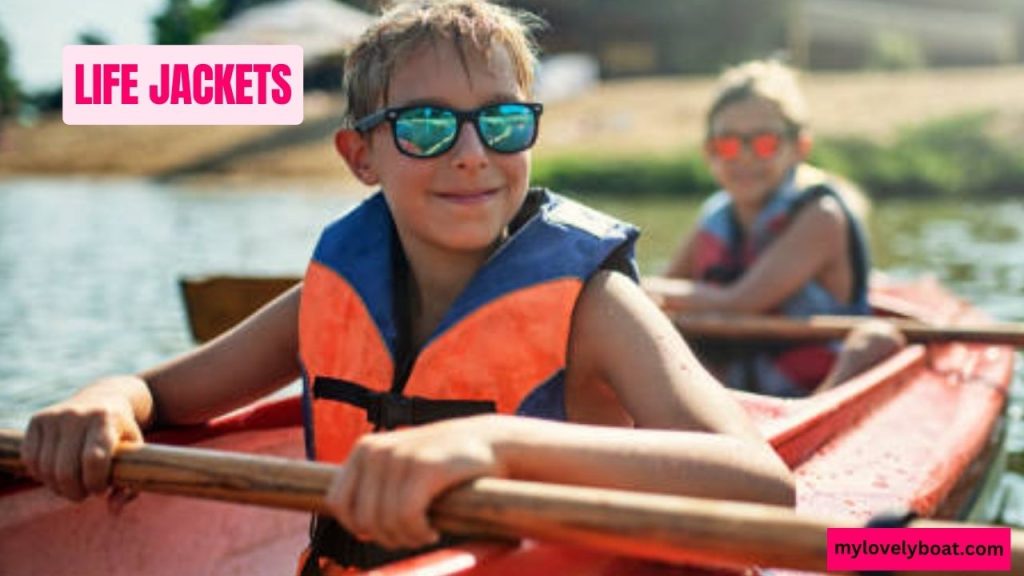
Life jackets are essential for children because they help keep them afloat and provide support in the event of an accident. Choosing the right life jacket size and fit is important for your child’s safety. Regular maintenance checks and learning how to use the life jacket properly make life jackets more effective and comfortable. Here are some tips for choosing and properly fitting life jackets for kids:
- Check weight limits: Ensure the life jacket is designed for your child’s weight range, as indicated on the label
- Opt for appropriate design: Choose a life jacket with a head support, crotch strap, and grab handle for younger children, as these features enhance safety and comfort.
- Test the fit: Have your child wear the life jacket and fasten all straps and buckles, ensuring a snug but comfortable fit.
- Perform the lift test: Gently lift your child by the life jacket’s shoulders; if the jacket stays in place and does not rise above the child’s ears, it fits correctly.
- Encourage practice: Allow your child to wear the life jacket in a controlled environment, such as a swimming pool, to become familiar with the feeling and buoyancy.
Parents can greatly enhance the safety and enjoyment of their child’s boating experience by selecting the appropriate life jacket and ensuring a proper fit.
2 – Adult Supervision
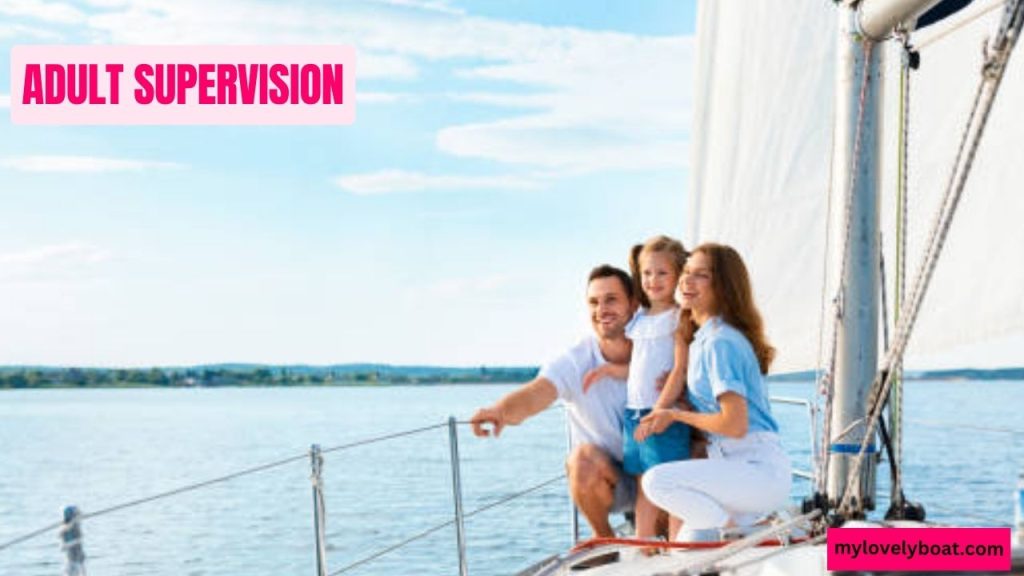
Constant adult supervision is crucial when boating with children to ensure their safety and well-being. To maintain a watchful eye, assign specific adults responsible for monitoring the kids throughout the trip.
This not only helps prevent accidents but also allows for quick action in case of an emergency. Parents can create a safer environment for their children and enjoy a more relaxed and enjoyable boating experience by having designated adults in charge of supervision.
Remember, a vigilant approach is crucial in preventing mishaps and ensuring a fun day on the water for everyone.
3 – Swimming Skills
Before going out on a boating trip, educating kids on basic swimming techniques and water safety regulations is important. It’s essential to teach them about situations on the water that require immediate action, which builds a prepared mindset. It also allows them to save themselves or others, which creates a safer environment. Here are some tips for teaching water safety rules to children:
- Start with the basics: Teach them essential swimming techniques such as floating, treading water, and basic strokes.
- Use visual aids: Use posters, videos, or picture books to help children understand and remember water safety rules.
- Practice role-playing: Act out different scenarios to help kids learn how to respond in various situations.
- Encourage open communication: Create a comfortable environment for children to ask questions and express concerns.
- Reinforce the rules: Regularly remind children of the importance of following water safety rules during boating trips.
By sharing these tips and fostering a safety culture, parents can help ensure a safe and enjoyable boating experience for the whole family.
4 – Emergency Procedures

Familiarizing kids with emergency procedures and equipment is crucial for their safety during boating adventures. This includes clarifying the functions of emergency flares or communication devices, practicing emergency drills, and the importance of staying calm and composed under pressure.. Here are some examples of emergency equipment and how to use them:
- Life jackets: Teach children how to properly wear and fasten life jackets, emphasizing their importance in staying afloat during emergencies.
- Fire extinguisher: Show kids where it is located and explain its purpose in extinguishing small fires on board.
- VHF radio: Teach children how to use the VHF radio to communicate with the Coast Guard or other boaters in case of an emergency.
- First aid kit: Familiarize kids with the kit’s contents and demonstrate basic first aid techniques, such as treating cuts or burns.
- Flares or distress signals: Explain their purpose and demonstrate how to use them to alert others for help.
Parents can help children stay calm and safe during unexpected situations on the water by teaching them about emergency equipment and procedures.
5 – Weather Conditions
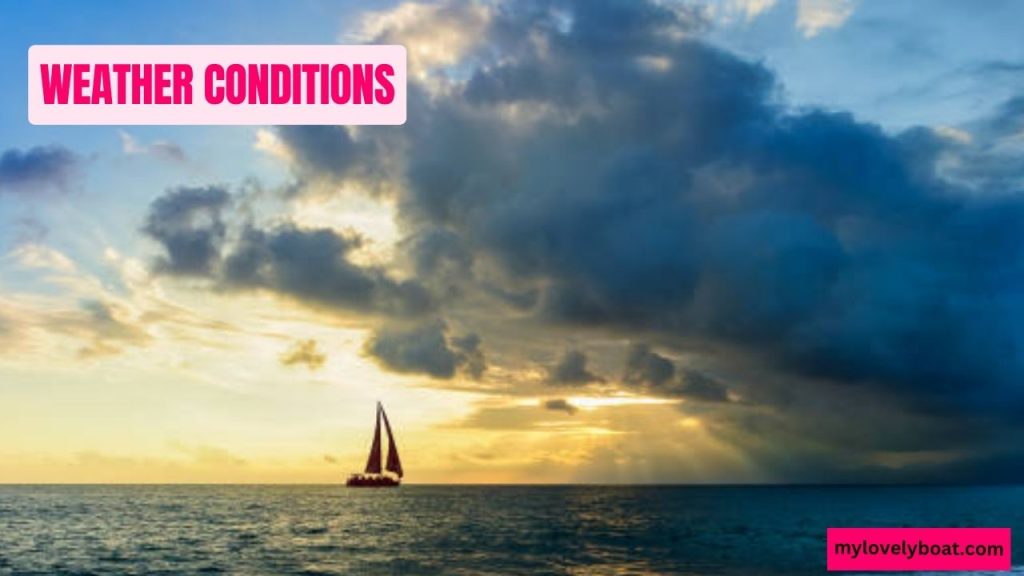
Staying alert to weather conditions is critical to boating safety. Unpredictable weather can pose significant risks, making monitoring conditions while on the water essential. Here are some tips for monitoring the weather while on the water:
- Consult weather apps or websites before departure to understand forecasts and potential hazards
- Observe the sky for changes in cloud formations, wind patterns, or sudden shifts in visibility
- Monitor temperature fluctuations, as sudden changes may indicate approaching weather systems
- Tune in to marine weather radio broadcasts for real-time updates and alerts
- Familiarize yourself with weather maps and charts to anticipate and respond to changing conditions
By staying vigilant and informed, boaters can ensure a safer and more enjoyable experience on the water.
6 – Boat Safety
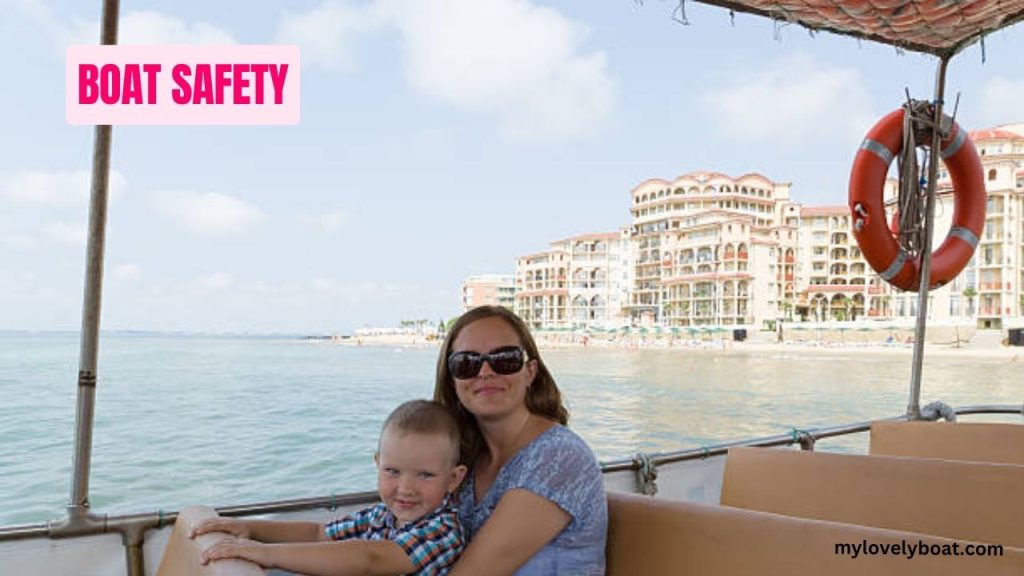
Teaching boat safety to children early is crucial for ensuring their security and well-being during aquatic adventures. Lessons should encompass a thorough understanding of the boat’s layout, proper usage of safety equipment, and the importance of following the boat rules and regulations. Here are some general boat safety rules to instill in young boaters:
- Avoid running or jumping on the boat
- Keep hands and feet inside the vessel at all times
- Wear a life jacket while on board
- Follow the captain’s instructions at all times
- Be aware of the surroundings and potential hazards in the water
- Know how to swim and stay close to the boat or shore
Prioritize boat safety by discussing these guidelines with your children and taking necessary precautions. Doing so can help prevent accidents and injuries, creating a safer and more enjoyable boating experience for everyone.
7 – Sun Protection
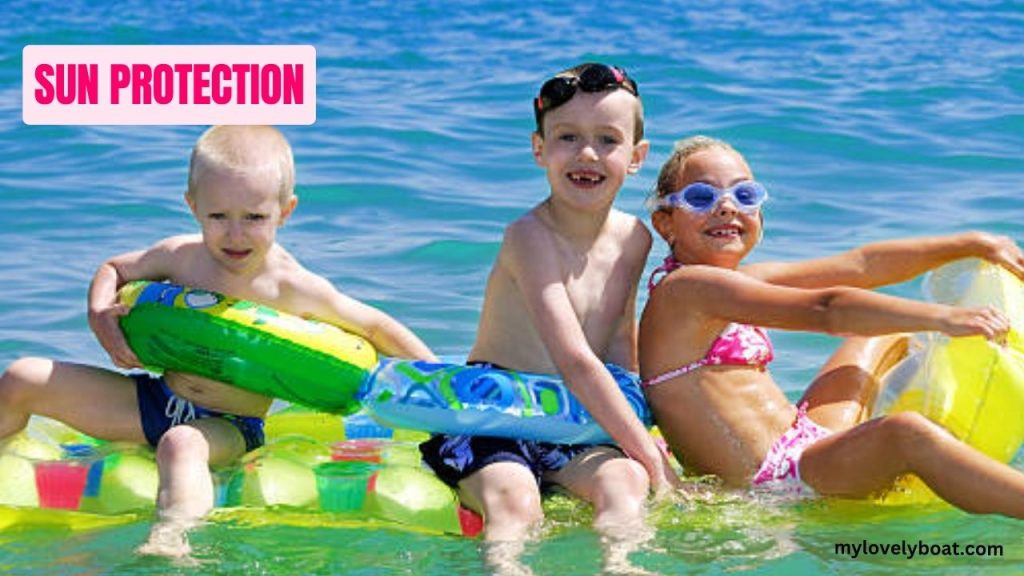
Sunburn is one of the most common causes of sunburn among children. Excessive exposure to the sun can cause painful burns and permanent damage to the skin. Ensure your child wears a wide spectrum sunscreen, protective clothing, sunglasses and a hat during a day out on the water. Taking breaks in shade areas can also help reduce sunburn damage. Here are some tips for ensuring proper sun protection while boating:
- Provide shade: Equip your boat with a bimini top or canopy to create shaded areas for children to rest and play.
- Apply sunscreen: Use a broad-spectrum sunscreen with an SPF of 30 or higher, and reapply every two hours or after swimming.
- Wear protective clothing: Dress children in long-sleeved shirts, wide-brimmed hats, and sunglasses to shield them from the sun’s rays.
- Limit exposure: Encourage kids to take breaks from direct sunlight, especially during peak hours (10 a.m. to 4 p.m.)
- Stay hydrated: Offer plenty of water or other hydrating beverages to prevent dehydration.
By prioritizing sun protection, parents can ensure their children a safer and more comfortable boating experience, reducing the risk of sunburn and its long-term effects.
8 – Hydration and Snacks
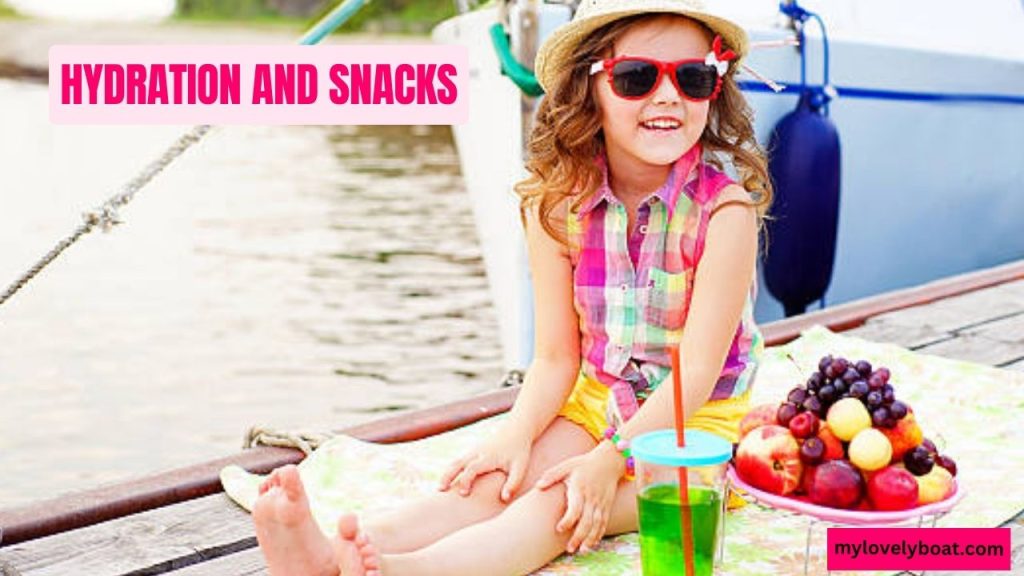
Kids need to stay hydrated throughout their boating trip. Hydration increases their energy levels and helps prevent dehydration. Ensure they have plenty of water and snacks, such as fruit and nuts. Take breaks for snacks and encourage them to drink water even when they don’t feel thirsty. Here are some ideas for healthy and easy-to-pack snacks:
- Fresh fruit: Opt for fruits like apples, oranges, or grapes that are easy to eat and not too messy
- Veggie sticks: Pack carrot, cucumber, or bell pepper sticks for a refreshing and nutritious snack
- Cheese and crackers: Combine whole-grain crackers with cheese slices or cheese sticks for a satisfying and portable option
- Granola bars: Choose low-sugar, high-fiber granola bars for a quick and convenient energy boost
- Nuts and seeds: Provide a mix of almonds, cashews, or sunflower seeds for a protein-rich snack
- Hydration: Bring plenty of water or electrolyte-enhanced beverages to keep kids hydrated throughout the day
By offering a variety of healthy snacks and prioritizing hydration, parents can ensure their children stay energized and comfortable during their boating adventures.
9 – First Aid Kit
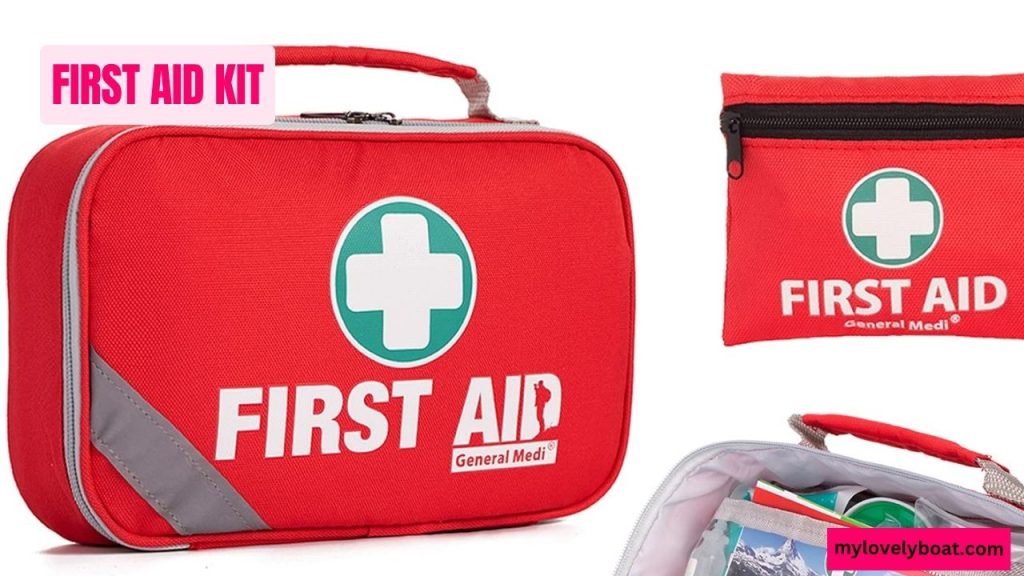
A well-stocked first aid kit is essential when boating with kids, as it enables you to respond quickly and effectively to emergencies. Here are some tips for using the first aid kit in case of an emergency:
- Assess the situation: Determine the appropriate course of action based on the nature and severity of the injury
- Clean wounds: Use antiseptic wipes or solution to clean any cuts, scrapes, or abrasions to prevent infection
- Apply bandages: Choose the appropriate size of bandage or dressing to cover the wound and protect it from further harm
- Administer medications: Follow instructions and age-appropriate dosages when providing pain relievers, fever reducers, or motion sickness medication
- Seek professional help: In case of severe injuries or worsening symptoms, contact emergency services or seek medical attention as soon as possible
By familiarizing yourself with the contents of your first aid kit and knowing how to use them effectively, you can ensure a safer and more enjoyable boating experience with kids.
10 – Communication
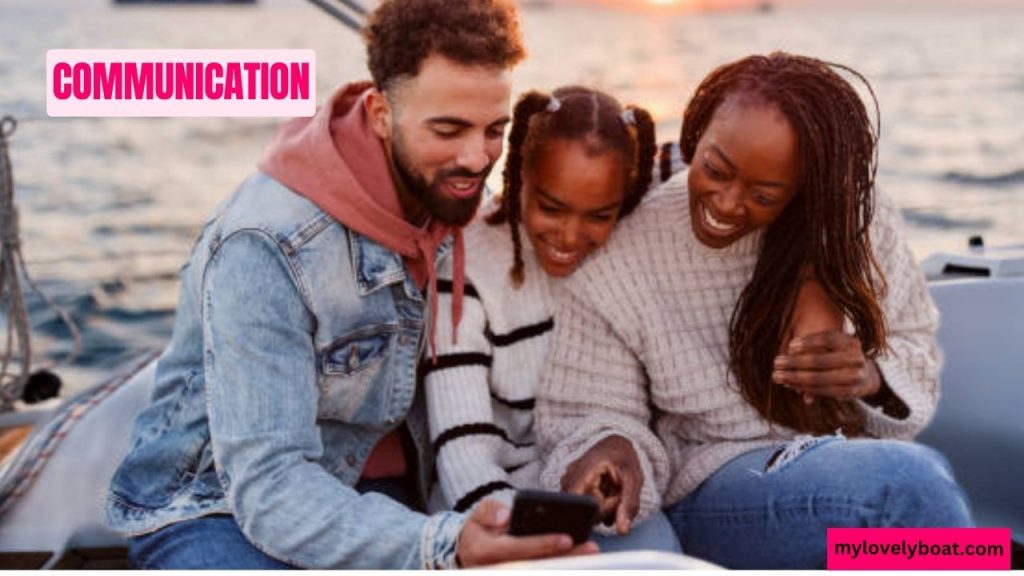
Clear communication between adults and children is crucial for a safe boating experience. Potential risks can be minimized by teaching kids to follow instructions and communicate effectively. Here are some tips to enhance communication:
- Establish ground rules: Explain the importance of listening and adhering to safety guidelines while on the boat to ensure everyone’s well-being
- Use age-appropriate language: Provide clear and concise instructions using simple terms children can easily understand.
- Encourage open dialogue: Invite kids to ask questions or voice concerns if unsure about instructions or safety rules.
- Reinforce understanding: Ask children to repeat back instructions, confirming their comprehension and retention.
- Create non-verbal cues: Develop a set of hand signals or gestures for situations when verbal communication may be challenging due to noise or distance.
By prioritizing effective communication, parents can create a safer and more enjoyable boating experience for the entire family, ensuring that children understand and follow essential safety guidelines.
FAQ-
How do you entertain a child on a boat?
Entertainment on a boat can come in various forms, like playing games such as scavenger hunts, story-telling, or wildlife spotting. These activities keep the child entertained and make the trip educational.
How can you be safe on a boat?
To ensure safety on a boat, always wear life jackets, conduct safety briefings, follow onboard safety protocols, and check weather forecasts. Also, having the necessary safety and emergency equipment onboard is crucial.
What can you do on a boat for fun?
You can engage in various activities for fun, like fishing, tubing, snorkelling (if your children are old enough), photography, or enjoying the scenic beauty and wildlife around you. Story-telling, star-gazing, and educational games can also be fun for kids.
How do you prepare for a boat ride?
Preparing for a boat ride involves:
- Checking the weather forecasts.
- Packing necessary safety gear and food supplies.
- Selecting a child-friendly itinerary.
- Ensuring the boat is in good condition.
A safety briefing before setting sail is also a must.
How do you describe a boat for kids?
A boat can be described to kids as a means of transport that floats on water. You can also explain various parts of the boat, like the cabin, the deck, the bow (front), and the stern (back).
How do you teach kids about marine life?
Teaching kids about marine life can be done through activities such as wildlife spotting and discussions about different species around. You can bring guidebooks or smartphone apps to help identify and learn about marine creatures.
What part of the boat is safest?
The safest part of the boat often depends on the circumstances, but generally, staying low and near the centre of the boat tends to be the safest as it’s the most stable part and less prone to capsizing.

I am a freelance writer passionate about watersports and the great outdoors. I have many years of experience in the marine industry, and I enjoy sharing my knowledge and expertise with others so that they can get the most out of their boating experiences. I like fishing, kayaking, and exploring new destinations by boat whenever I have time. Contact Us: Linkedin
